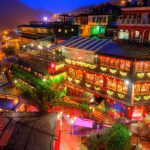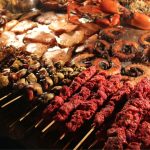Table of Contents
After spending two years exploring Japan’s culinary landscape, from convenience store Onigiri to three-star Michelin experiences, I’ve learned that food tourism in Japan requires strategy, cultural understanding, and an adventurous palate. Here’s your comprehensive guide to experiencing Japan’s incredible food culture beyond the typical sushi and ramen recommendations.
The Morning Market Strategy
Start where Japanese food begins – the markets. Tsukiji’s outer market still thrives despite the inner market’s relocation. Arrive by 7 AM to watch restaurant owners selecting their daily ingredients and sample fresh seafood breakfast. Kanazawa’s Omicho Market offers a less touristy alternative, where local vendors have time to explain their products. Learn market etiquette: no touching food without permission, no eating while walking, and always carry small change for samples. Most markets offer guided tours starting at 6 AM – book these through local guide associations for the best experience. Look for vendors displaying the “English OK” sign, and don’t miss the traditional breakfast spots hidden in the market’s corners where chefs grab their morning meals.
The Konbini Revolution
Japanese convenience stores aren’t just quick stops – they’re culinary destinations. Each chain (7-Eleven, Lawson, FamilyMart) has unique specialties worth trying. The food quality rivals many restaurants, with items refreshed multiple times daily. Try seasonal onigiri, fresh sandwiches, and hot foods like karaage chicken. Best time to visit? Around 4 PM when fresh bento boxes arrive, or early morning for just-baked bread and coffee. Each season brings limited-edition items worth seeking out. 7-Eleven excels in Oden during winter, while Lawson’s fried chicken has a cult following. Download the chain’s apps for point cards and special promotions that locals use to maximize value.
The Ramen Reality
Real ramen exploration goes beyond tourist spots. Each region has its style: Sapporo’s miso, Hakata’s tonkotsu, Tokyo’s shoyu. Use ticket machines to order – most have English buttons or picture menus. The best shops often have lines; go during off-peak hours (3-5 PM) for shorter waits. Look for shops displaying “日本一” (Japan’s Best) signs – these have won national competitions. True ramen aficionados should download the Ramen Beast app for detailed reviews and rankings. Pay attention to shops’ specific rules – some don’t allow photography or require complete silence while eating. The best ramen shops often close once they’ve sold out of their daily broth allocation.
The Izakaya Experience
Izakayas offers Japan’s best food-and-drink pairing experiences. These casual pubs serve small plates perfect for exploration. Look for places filled with office workers rather than tourists. Learn essential phrases like “Osusume wa nan desu ka?” (What do you recommend?) and “Omakase de” (Chef’s choice). Most places offer picture menus, but the daily specials board often holds the best items. Understanding the seating system is crucial – some izakayas charge different rates for counter, table, or tatami seating. Always check if there’s a cover charge (otoshi) before sitting down. The best izakayas often have a time limit during peak hours, usually two hours for dinner service.
The Regional Specialties
Each prefecture has distinct specialties you won’t find elsewhere. Osaka’s street food culture centers around kushikatsu and okonomiyaki. Fukuoka’s yatai stalls serve unique variations of ramen and grilled items. Research regional dishes before visiting each area. Local tourist offices often provide food maps highlighting specialized restaurants. Many regions host annual food festivals celebrating their specialties – timing your visit around these events offers the best variety and value. Look for restaurants displaying the “Local Specialty Certification” mark, indicating they meet regional standards for traditional preparation methods. Some areas offer food passes that include multiple specialty restaurants at a discount.
The Seasonal Sensibility
Japanese cuisine revolves around seasonality. Spring brings sakura-flavored everything, summer offers light noodle dishes, autumn features matsutake mushrooms, and winter brings hot pot dishes. Department store food halls (depachika) showcase seasonal specialties. Follow the “shun” (seasonal peak) calendar for the best eating experiences.
The Fine Dining Protocol
High-end Japanese dining requires preparation. Make reservations months in advance through your hotel concierge or specialist booking services. Learn basic etiquette: no strong perfumes, arrive exactly on time, and don’t photograph without permission. Many top restaurants offer lunch sets at a fraction of dinner prices with similar quality.
Understanding the various styles is crucial – kaiseki differs from kappo, while omakase sushi experiences have their own protocols. For Michelin-starred restaurants, book 3-6 months ahead, ideally through a concierge service that specializes in fine dining. Some establishments require a local reference or prior dining experience at a sister restaurant.
Master the basics of chopstick etiquette: never pass food chopstick-to-chopstick, don’t stick them vertically in rice, and place them on the rest between courses. When eating sushi, use fingers for nigiri and chopsticks for sashimi. Most high-end restaurants provide an English-speaking server, but learning basic Japanese dining terms shows respect.
The Street Food Scene
Despite Japan’s reputation for formality, street food thrives at festivals and specific districts. Osaka’s Dotonbori and Tokyo’s Asakusa offer concentrated street food experiences. Temple festivals (matsuri) feature yatai stalls with regional specialties. Always look for stalls with lines of locals and visible cooking areas.
The best street food experiences often happen during seasonal festivals. Summer brings unique kakigōri (shaved ice) variations, while winter festivals feature amazake (sweet fermented rice drink) and roasted sweet potatoes. Each region has its own festival specialties – research local event calendars to time your visit.
Learn the unspoken rules: no walking while eating, dispose of skewers properly, and respect queuing etiquette. Many street food vendors specialize in one item perfected over generations. Look for stalls displaying the year they were established – older ones often maintain traditional recipes passed down through families.
The Tea Ceremony Connection
Traditional tea ceremonies offer insights into Japanese food culture’s foundations. Beyond matcha, learn about seasonal wagashi (sweets) and the philosophy behind food presentation. Many cities offer tourist-friendly tea experiences but seek out smaller establishments for more authentic interactions.
The best tea experiences happen in private homes or small tea rooms (chashitsu) rather than tourist centers. Consider taking a wagashi-making class to understand the symbolic meanings behind seasonal sweets. Many traditional confectioners offer workshops where you can learn about the relationship between tea and sweets.
Understanding the seasonal aspects is crucial – different types of tea ceremonies correspond to specific seasons and occasions. Some tea houses require an introduction from a regular customer, but many now offer beginner-friendly sessions with English explanations. Look for ceremonies conducted by certified tea masters who can explain the philosophical aspects of this cultural cornerstone.
The Hidden Gems
The best food experiences often hide in unexpected places. Train station restaurants serve excellent meals, especially in major stations. Department store basements offer high-quality prepared foods. Look for restaurants with vending machine tickets – they’re often family-run gems focusing on one specialty. Ready to explore Japan’s incredible culinary landscape?

I’m Garrett, a seasoned photojournalist with a passion for uncovering the world’s hidden treasures. My journey is fueled by a deep curiosity for diverse cultures and breathtaking landscapes. When I’m not behind the lens capturing the world’s wonders, you can find me exploring underwater realms or sharing my passion for discovery with my two adventurous children.




